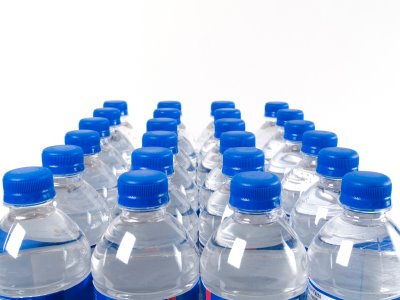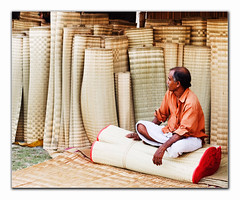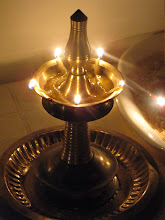Image: sustainablefootprints.org
Is it just me, or does anyone else find this a sheer waste of resources and an unnecessary strain on the planet?
Whenever I see these ads for disposable water bottles or any other bottled products, I think of the landfill and the millions of gallons of crude oil which went into manufacture, transportation and disposal (recycling or garbage trucks) of these plastic bottles.
Let us take the case of bottled water in particular. Call it mineral water, spring water or just plain bottled water, other than its name, it is no different from water boiled on a medium high for 20minutes. Arguments come up discussing pros and cons of boiling water and wasting fuel / energy etc. Come to think of it, our planet pays a heavy price to support our current lifestyle. The least we could do is to think of trade offs and make least destructive choices.
A very popular ad for a very prominent water filter products company provides statistics for the number of bottles ending up in a landfill after serving just a few sips. I quote " 30 minutes in your hand and forever in the landfill". Lets face it, disposable water bottles mean more garbage, which cannot bio-degrade for the next 10 million years. Every bit of plastic produced in the world is lurking in some corner of the world.
Imagesource:athensboy.wordpress.com
Recycling?
Very learned friends of mine argue that they recycle, with out even understanding the basics of recycling. Recycling, even in the United States for that matter, is at its nascence. More than 85% of the plastic produced
cannot be recycled. Turning one harmful plastic product into another and trying to stretch its "life" is no use. It is like committing an offence to cover up the first one.
Also, the entire process of recycling is a serious strain on the planet. Think about all the resources which go into the so-called process of recycling. I hate to say this, but I cannot understand the ignorance of people who claim they are eco-friendly because they recycle.
Hey! one question for you, cant you think of ways to avoid something if possible rather than leave a footprint?
Imagesource: banquetevent.com
Why the Industry needs you to be ignorant...
Bottled water is reported to be the fastest growing bottled beverage product for small and large players, worldwide. If you are among those who are convinced that bottled water is better, then I have news for you. Most of the tap water available in the developed world is potable, and in the rest of the world, filtering it at home and boiling it for 20 minutes makes it safe.
Buying a bottle of any brand means diverting precious fossil fuels to this unsustainable industry. Not to forget the heavy environmental cost, added plastic to landfills and unwanted pressure on natural springs ( if in case it really is spring water). Adding to the already existing mess are innovation in the bottled water business - coloured water and “vitamin” water varieties.(That needs a separate post!)
More than 75% of water bottled by name brand beverage companies are sourced locally to minimize operational costs. Living in a city like Hyderabad, India if you thought you were being served fresh spring water from a spring in the Himalayas, you are in for a rude shock. Bottling companies actually filter and treat locally available ground or surface water and cannot afford to sell spring or mineral water
(whatever their definition of mineral water is!). This applies to every brand /company operating from any location, world wide.
Now what?
Given this fact, what I fail to understand is why does the very same population who swears by a bottle of store bought water have no qualms about gulping down gallons and gallons of soft drinks from a vending fountain. Do they assume that the soft drink doesn't contain water at all or do they think that a soda fountain pumps out fresh spring water from the alpines?
Major soft drink manufacturers follow a standard processes and operational models to retail their wares. Cylinders and tanks containing concentrated "drink mixes" are shipped across dealer locations and those dealers and vendors mix in locally available water to bottle or fill in the dispensing machines. So it actually does not make any sense to buy bottled water and also buy soda (bottled or the dispensed ones)
In reality, bottled water is just plain tap water. EPA is more stringent about the quality tap water supplied across the USA when compared to rules applied to bottled water and products.
It is a sharp contrast to the fact that USA is the largest market for bottled water followed by Mexico and China. Loopholes in the law add to existing confusion regarding eco-friendly policies to be manufacturers and retailers. Also,
laws applicable to bottled water manufacturing and supply vary by region. Legislation applicable in Australia are different from the ones in European Union or the USA making crusading againt this all the more difficult.
People don't stop buying it because there is no one to revert these false notions created by bottling companies and their media partners. Bottled water is a major revenue generater for every soft beverage manufacturer in worldwide. For example, Pepsi owns Aquafina and Coke operates under the name "kindle" in India and "Dasani" here in the United States Bottled water sales is anywhere between $50 and $100 billion each year, with the market expanding at the startling annual rate of 7 percent so would they kill their golden goose? Definitely not!
Then why this hoard to stock up crates of "bottled water"?
Image source: engineeringdaily.net
The answer lies in the minds of millions of mis-informed people who have been convinced that tap water filter by traditional methods is not safe for consumption. And now they believe that water is not good unless it is poured out of a stinky disposable bottle. One look at the labels or the bottled water ads; you will find deep, clear pools of spring water; majestic mountain peaks; healthy, active people gulping down chilled bottled water while biking in the park or in aerobic and yoga classes. Impressive right...the ad gurus at work again...But what happens to our common sense when we see all this? goes for a toss.
But the reality is that tap water is actually held to more stringent quality standards than bottled water, and some brands of bottled water are just tap water in disguise.
Do we really need this?
Imagesource: greenbabyguide.com
Imagesource:thewere42.files.wordpress.com
Did you know that a simple washed old cotton sari or a cotton cloth folded into eight is among the best water filter you an ever find? Refer to this article online:
Study reveals sari cloth filtration reduces cholera. (Environmental Intelligence.
It pains to see pictures like these were women are forced to harvest rain water or walk miles for a pot of water.
Imagesource: iwmai.cgiar.org
Imagesource:bp.blogspot.com
Why isnt this fact being propagated in a nation somewhere in Africa or in Asian nations such as India, Bangladesh or Sri lanka? Simply because creating awareness would mean decrease in demand for bottled water. This non profitable means to provide better health to the larger population doesn't end up in business growth, kick backs or pay backs of any kind to anyone. So why would they even work towards creating this awareness.
A new factory set up by Coke in a remote village in Andhra Pradesh or Gujarat means more money for the government. The fact that this very factory leads to depleting fertility levels, and a severe drop in ground water levels in the surrounding areas, means nothing to the decisio makers!
You can help ....For starters, If you are phobic about drinking tap water, you could buy a water filter/pitcher (a lesser evil when compared to bottled water).
Imagesource:muchinfo.com
Start making intelligent choices and live well...Let's let the planet breath!
Read more...













































